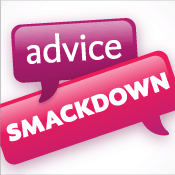
Toddlers Who Pull Hair
Hi Amy,
My otherwise sweet-natured 16-month-old daughter is a terror when it comes to hair pulling and I am at my wits’end with it. I have long hair and she delights in grabbing it with both hands and yanking hard. It’s agony! And she won’t let go either – she tangles her fingers in there and holds on, and sometimes it takes two people to disentangle her.

Do you have any tips for dealing with this? My instincts are that she’s too little to understand a time-out, but is there any other form of appropriate punishment that might get through to her? I am really tired of flinching every time she comes over to me for a cuddle because I’m afraid it’s just a cover for her to get at my hair (and usually that’s exactly what it is!) and I would maybe one day like to be able to wear my hair down around her without fear!
Thanks!
Oh, maaaaan…my scalp was flinching in sympathetic agony while reading your email, because yeah. The hair-pulling stage! It’s a fun one, all right.
For starters, take comfort in the fact that your daughter mostly seems to only being pulling YOUR hair, with the “YAY THIS GAME IS FUN” impulse, rather than, say, yanking on their playmate’s or sibling’s hair over each and every little sharing/”stop bugging me” confrontation. It hurts when it’s your hair, but at least it’s sliiiightly less mortifying than realizing your otherwise-sweet-natured child is angrily and deliberately making other kids howl in pain over one of two dozen interchangeable blue cars.
(GIVES EZR– my second child –THE STINK EYE. THANKS FOR ALL THAT, KID.)
And more good news: So totally a phase. She’ll outgrow it, really and truly, once her social skills and vocabulary mature and she’s a tad more capable of empathy and/or impulse control. I’d say…give it two more months, or until her first big burst of language. It’s a pain, yes, but don’t worry: It’s a relatively normal, harmless phase while she delights in cause-and-effect, and not indicative of future cruelty or playground fist fights.
In the meantime,
Five things you can do to get your toddler to stop pulling your hair:
1. Keep your hair back.
I wore mine up in a claw clip, French twist style (so no ponytail to yank), and would often add extra protection to the front of my head with a wide fabric headband. Removing the temptation was usually the most sure-fire solution, even if it wasn’t the most fashionable.
2. Give her something else to pull on.
Invest in “nursing necklaces” or “teething jewelry.” These are cute, baby-proof necklaces for moms, designed for a nursing/teething baby to tug and chew and yank on to her heart’s content. I used one like this during the teething phase and brought it back into play when Ezra went through the I JUST WANT TO GRAB YOUR HAIR/FACE/NECK SKIN AND SQUEEEEEEEEZE phase. Something like this might also be attractive to a yanky, grabby toddler.
3. Be calm and consistent.
Don’t take it personally. She really doesn’t understand that she’s hurting you. She doesn’t understand that laughing hurts your feelings. She just really, really digs the reaction she gets when you do yelp or flinch or bite your lip and scrunch up your eyes while you try NOT to yelp or flinch, and dagnabbit, she’s gonna try and try to make you do that again. Punishments like timeouts (or yanking her hair in return to “show her how it feels”) are just not developmentally appropriate OR likely to be all that effective. “No pulling hair. Pulling hair hurts.” Take her hand, stroke gently over your hair to model. Over and over and over again. The only way through it is through.
4. Try some preferred hair-related play.
In addition to showing her the correct way to handle someone else’s hair right after a pulling incident, you might (if you’re brave enough) want to hand her a hairbrush or comb and let her start playing with Mama’s hair. If you bathe or shower together, let her have a go at lathering the shampoo on your head. If it disintegrates into pulling, the game/privilege is immediately over…so if it turns out to be something she enjoys doing, she MIGHT catch on that hey, I need NOT DO THAT in order to keep playing.
Alternatively, if you aren’t ready to offer up your own scalp as a guinea big, get her a long-haired doll or stuffed animal (like a lion with a mane) and a toy comb or brush. Show her the right way to treat its hair, and if she pulls it — well, no real biggie, but take the opportunity to talk about the toy’s feelings. “Dolly is sad! That hurts! She doesn’t want to play anymore. Oh, dear.”
5. Sign language.
Personally, I found sign language REALLY effective to give my toddlers a way to express words and concepts that they were still months away from using in speech, like “hurt” and “sorry.” If you can teach your daughter to use the sign for hurt (it’s just tapping the tips of your index fingers together) when SHE is hurt or has a boo-boo, it might help connect the dots just a bit sooner for her when she sees YOU use it after a hair-pulling incident. Find more on baby sign language here.
Again: PHASE. She’ll get past it, I promise. You will wear your hair down again! Some of these suggestions may go completely over her head, and you’ll just need to wait it out, as calmly as possible. But hey, sometimes you just need to feel like you’re doing SOMETHING akin to actual parenting as opposed to…wild, lawless cat-herding, right?
Photo credit: Thinkstock

